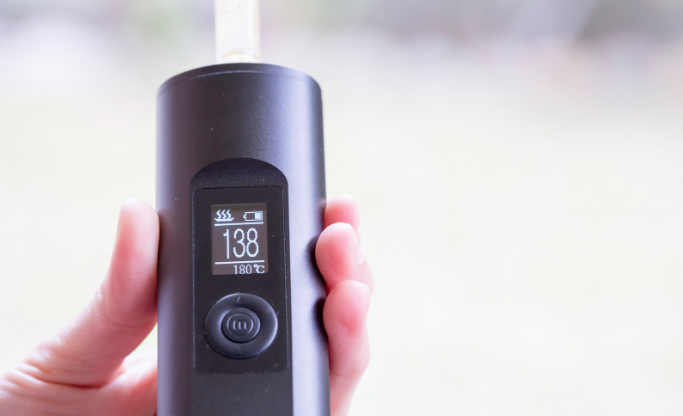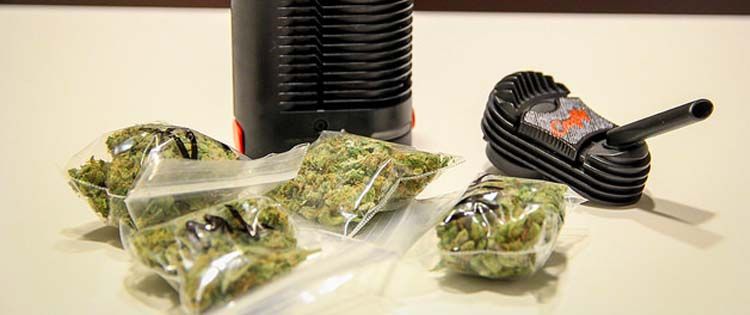Cannabis users looking for the smartest ways (from a health perspective) to use cannabis have countless options to get the benefits they’re looking for.
Whether it’s smoking from a bong, using a dry herb vaporizer, baking edibles in an oven, or using extremely potent drops of cannabis oil, all of these methods are less harmful to your health than simply smoking a joint.
Because edibles like cannabis-cakes and cannabis oils are a bit trickier to dose than dosing cannabis using other methods and usually less convenient to use, the majority of health-conscious cannabis users are either interested in:
- Vaping, or
- Bonging.
Today we’ll explore the pros and cons of both methods of cannabis-use from a health perspective.
Let’s get started. First, let’s explore…

Why Smoking a Joint is the Most Harmful Way (for your Health) to Use Your Cannabis
Smoking any type of plant material, whether it’s cannabis, tobacco or something else, is always harmful to your health.
Here’s why:
The act of burning any plant material releases toxins, irritants and carcinogens that are harmful to your health.
Especially, tar, which is the resinous particulate matter, that gets produced as a by-product of burning plant material is extremely harmful to your health in many ways.
When you inhale tar, you not only damage your lungs over time through various biochemical processes that are associated with cancer and other diseases, but you also damage your airways, mouth, gums, and taste buds in, sometimes, irreversible ways.
Now, some researchers think that the cannabinoids found in cannabis (like THC and CBD) have a protective effect on your lungs and airways and that’s the reason why some studies never found a clear link between smoking cannabis and lung cancer (like they did with tobacco/cigarettes).
Based on the results of the current studies that looked at cannabis smoke and cancer, it’s unclear whether smoking joints will increase your risk of lung cancer.

But what we do know with certainty is that:
Smoking cannabis in the form of a joint increases your risk to develop countless respiratory symptoms like wheeze and airway inflammation.
And while studies are great to back-up human experience, whoever had a night of heavy joint-smoking, must have experienced the effects of smoking joints on the respiratory system first-hand…waking up, coughing, wheezing, and gurgling up phlegm (not a nice experience).
So, it’s not strange that cannabis users look for an alternative to smoking joints.
Now, the two most straightforward alternatives to smoking joints are:
- (although this still is a form of smoking) Bongs, and
- Dry herb vapes.
Which one is the least harmful method to use your cannabis?
The Pros and Cons of Vaping vs Bongs
First, we have to understand what makes using a bong to smoke your cannabis, in theory, less harmful than smoking a joint.
A bong is usually a glass piece, that has a compartment with some water. The important part here is the compartment with water.
The whole point of a bong is that the cannabis-smoke goes through the water that’s inside that compartment, and filters out a large part of the tar, toxins and irritants.
A few studies have shown that bongs indeed filter a significant amount of tar, toxins and irritants from marijuana smoke.
But the same studies also found that water pipes and bongs also filter a significant amount of cannabinoids.
In some cases, the amount of cannabinoids filtered out of the smoke was so high that, relatively speaking, you would get a lower cannabinoid-to-tar ratio than with a regular joint.
This, of course, isn’t what most cannabis users would want, because then you might need to smoke more cannabis to achieve the same effects as you would get from a joint, without reducing the total tar intake.
But this process could also work the other way around, you might need less cannabinoids than you think to achieve the effects you want and a bong could help you fine-dose your cannabinoids in a more refined way.

Important to note here is that the volume of water in the water compartment of the bong has an influence on the filtering aspect. The more water in the bong, the lower the cannabinoid-to-tar ratio, so the more cannabinoids get filtered compared to the tar, relatively.
Also, important to note here is that tar is a complex compound consisting of many different chemical components, some being more harmful than others. Even though a bong might give you a lower cannabinoid-to-tar ratio, it could be that it’s still less harmful than a joint if the chemical make-up of the tar consists mostly of less harmful chemical components.
The main take-away here is that to get most benefits from the water-filtration inside a bong, use relatively little water.
Now:
Dry herb vaporizers on the other hand, if used correctly and of a high enough quality, will always increase the cannabinoid-to-tar ratio. That means that with a vaporizer, you’ll always get more cannabinoids than tar compared to smoking a joint, but also compared to using a bong.
But the comparison of using a bong vs a dry herb vaporizer wouldn’t be complete without taking the materials that these vehicles of cannabis consumption are made of.
A huge pro of using a bong from a health perspective is that bongs are always made of glass.
Glass is the most inert material that you can use as a vehicle to smoke your cannabis. Glass doesn’t leak or react with anything (compared to metals for example in a dry herb vaporizer).
With a bong, you’re getting pure and unadulterated cannabis products and by-products. Everything you inhale out of a bong, comes from the cannabis.
A dry herb vaporizer usually is made of many different types of materials but the most common ones are metals (aluminum, stainless steel), plastic, ceramic, silicone and glass.
As you can see, glass is only 1 of the many materials and, there aren’t any full glass dry herb vaporizers, and some dry herb vaporizers have no glass at all in their design.
Now, these other materials aren’t necessarily harmful for your health, but they can be. Whether these other materials are going to be harmful for your health is highly dependent on the quality of the material and the design choices made regarding the material.
Plastic, for example, shouldn’t be next to a heating element that reaches high temperatures.
With glass you don’t have this problem at all. Glass can be incorporated anywhere and can withstand extremely high temperatures, always.

What this all means is that with a dry herb vaporizer, depending on the quality of the vaporizer, there’s always a small risk that you’ll inhale metals or other toxic products that leak into the vapor.
That’s why we at Herbonaut always recommend getting a dry herb vaporizer from a trusted manufacturer that’s transparent about their materials and design. With a bong, you don’t have this issue.
Conclusion
So, which one is less harmful to your health, bonging or vaping?
Unfortunately, there’s no clear answer.
If you’ve got yourself a high-quality dry herb vaporizer from a manufacturer that used the right materials of the right quality, in the right places, chances are that vaping is less harmful to your health than using a bong/water pipe because of the high amount of tar it filters, without filtering out a high amount of cannabinoids.
To compare the latest dry herb vaporizers visit Herbonaut.com, where they review the latest models.
If, however, you’ve got yourself a dry herb vaporizer from an unregulated auction-like website like Alibaba Express or eBay, chances are that you seriously put your health at risk by the potential leaking of toxic compounds from the materials used in your dry herb vaporizer.
- Bomb Pro Electric Dab Rig Review - April 19, 2024
- How to Use Waxmaid Honey Pen? - April 9, 2024
- How To Choose The Best Electric Dab Rig For Christmas - December 7, 2023


